Now that my daughter and I have joined forces to hike together this summer, I have adjusted our process. How many rests do we need? How long should each rest be so it restores us without leaving either of us cold? What is the best way to keep younger hikers interested and occupied? For that matter, when older hikers grow tired, can we coax more mileage from them? How much mileage and gain is too much? Since last Thursday’s visit to Annette Lake, I compiled a list of tips to coach and coax new hikers forward.
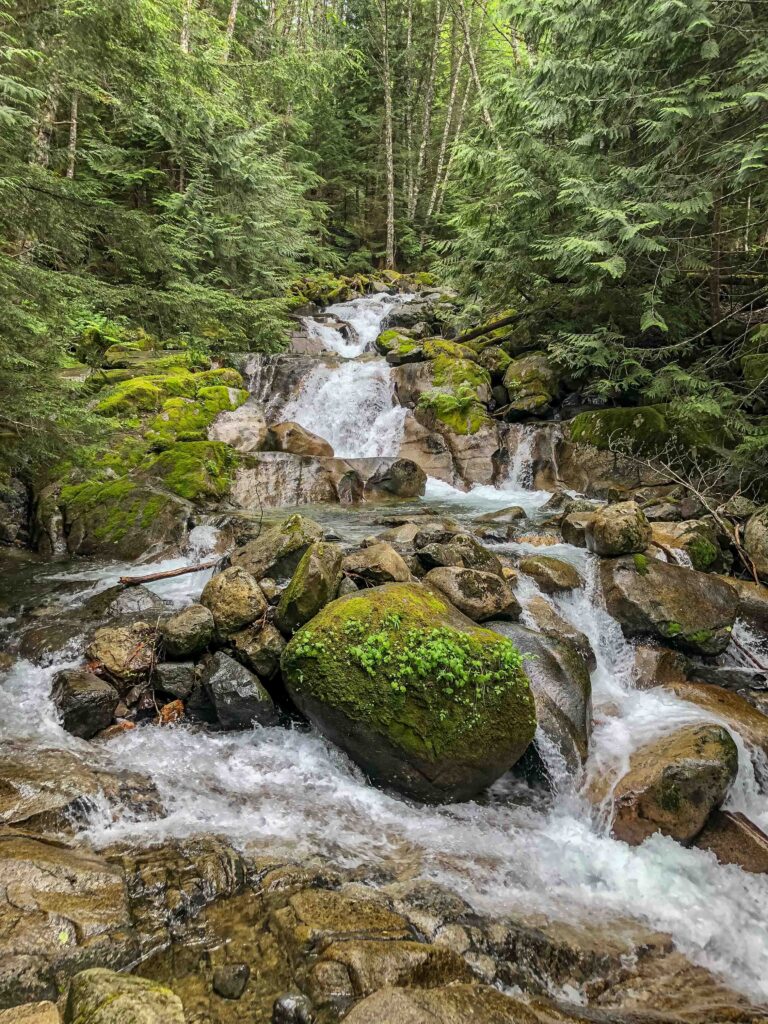
Coax New Hikers by Giving Them a Choice
Regardless of age, hikers will likely have more success on their outings if they are involved in choosing (and getting excited about) a destination. Before each hike, I ask my daughter what she’s interested in seeing. We use the WTA hikes finder to locate suitable hikes that include lakes.
From her baseline hike to Teneriffe Falls, we also have a better understanding of what elevation gain and mileage will be comfortable for her. We compiled a list of appropriate hikes from which she can choose based on the weather and how she feels on any given day.

Hikes Under 8 Miles and Less Than 2000′ Elevation Gain
Here’s our shortlist (in alphabetical order) of Pacific Northwest hikes east of Seattle that we plan to visit this summer. All are between 5 and 8 miles and involve 1000′ to 2000′ elevation gain.
- Annette Lake 7.5 miles 1800′ elevation gain (Blog 96)
- Grand Ridge Park 7 miles, 1100′ elevation gain near Exit 20 off I-90
- Lake 22 5.4 miles, 1350′ elevation gain on the Mountain Loop Highway
- Margaret’s Way and Debbie’s View on Squak Mountain, 6.5 miles, 1500′ elevation gain near Exit 15 (Blog 99)
- Mirror Lake 7 miles, 1180′ elevation gain near the PCT at Exit 54
- Poo Poo Point on Tiger Mountain, 7.2 miles, 1748′ elevation gain near Exit 20 off I-90
- Snow Lake 7.2 miles 1800′ gain near Exit 52
- Talapus and Olallie Lakes 6.2 miles, 1220′ elevation gain near Exit 47 (this week’s trip, Blog 98)
- Teneriffe Falls 5.6 miles 1585′ elevation gain and our first trip together (Blog 95)
- Wallace Falls 5.6 miles, 1300′ elevation gain (our Father’s Day trip, Blog 97) on US 2
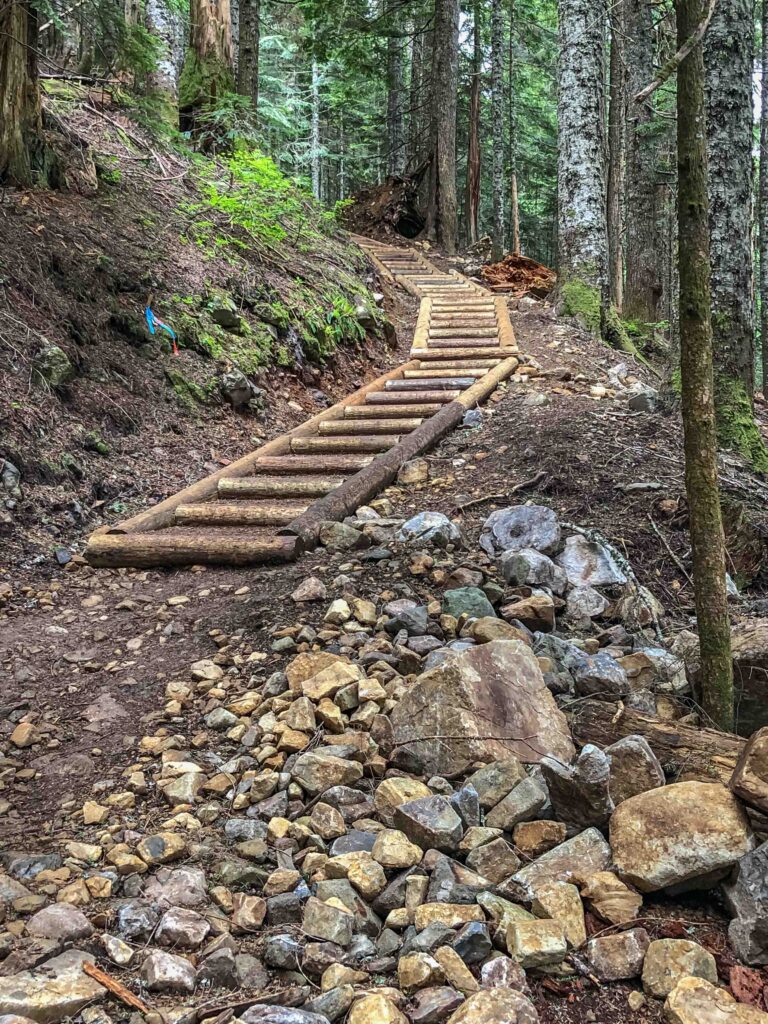
Take Frequent Breaks
Another way to coax newer hikers forward is to plan frequent breaks. From our first hike together (as well as from decades of experience) I know that taking a short clothing and water break about 15-20 minutes into the hike allows an assessment of how everyone feels. With young kids that may be more like every 10 minutes.
Our modified plan is to check in with each other every 20-30 minutes. Sometimes when I’m alone with Ajax, I’ll go a whole hour before taking a water break.
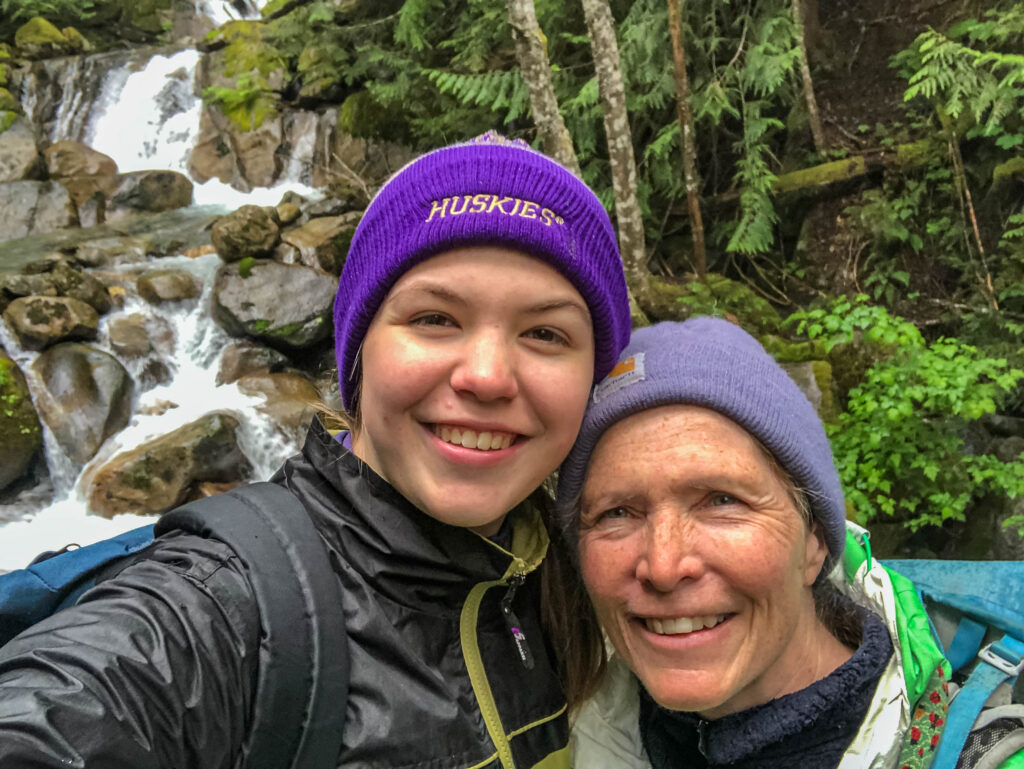
No Regrets
After what felt like the umpteenth switchback, I could tell my daughter was getting tired. It was chilly and damp, and she had less oomph than she did on our previous hike to Teneriffe Falls. I used the phrase, “Just a little farther!” one too many times, and she ground to a halt. I figured that 52 minutes was close enough to an hour to merit a longer rest.
At that point, my daughter asked if I regretted inviting her to join me. I was shocked. “Absolutely not!” I replied. Her question reminded me that there’s more to communication than words. Could I be sending out vibes she’d misinterpreted? I joined her on the log. While I may long for the carefree pace I set whenever I go alone, I can do that anytime. But hiking with her is a rare gift that I wouldn’t trade for anything.

Demonstrate Proper Pacing
A mistake new hikers sometimes make is starting from the cars too hard or too fast, resulting in early fatigue. Just like any warmup to a workout, try suggesting easing into the hike for the first half mile. This allows the muscles, tendons, ligaments, and joints plenty of warm-up time before sustained exertion. Then, after removing a layer of clothing, you can settle into your “go forever” pace.
My daughter has demonstrated that she does not like to be the last member in a hike. If she can’t be part of a “kid sandwich” (i.e. adult – child – adult) then she would rather be out front. My goal in upcoming hikes will be to try to teach her suitable pacing (e.g. no sprint/stop allowed) without requiring that she walk behind me. Maybe we can find hikes with wide trails.
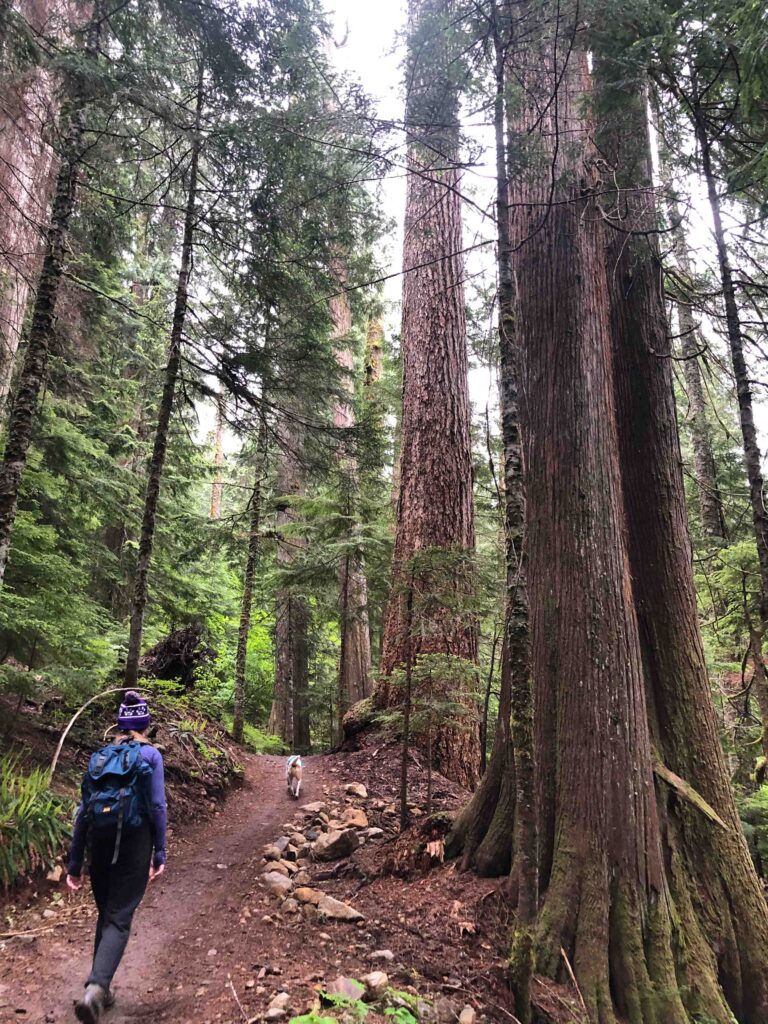
Coax New Hikers by Providing Suitable Rewards
As we learned two summers ago on a trip to Mt. Catherine, when the huckleberries and blueberries were ripe and abundant, having some sort of reward can go a long way toward motivating a newer hiker. The promise of reaching snow in June was a big lure.
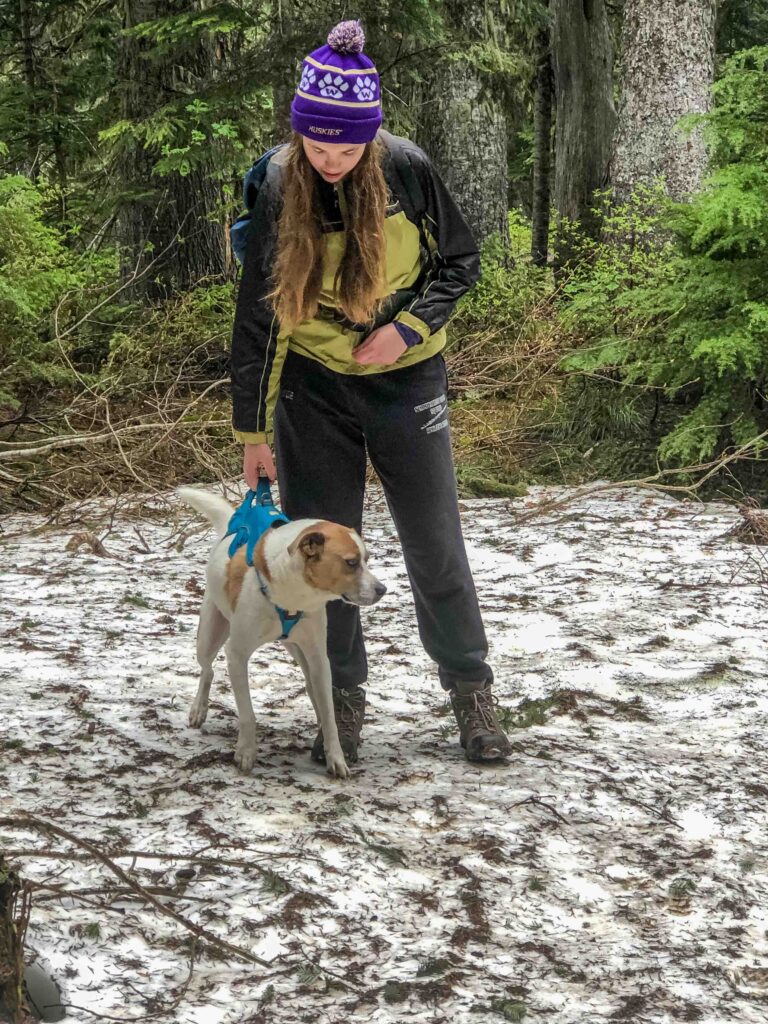
When our daughter was young, it was the promise of ice cream afterward. On this trip, I brought out crisp snap pea chips. We spent half an hour at the lake before we both got a little cold.
As soon as the activity itself becomes a reward, you know you’ve got a hiker for life. The fact that we have our next two outings lined up means that all those outings years ago with the Mountaineers Family Activities group have created strong roots. I couldn’t be happier. If you have tips for coaching or coaxing the newer hiker, please share them in the comments so we can all learn from each other.
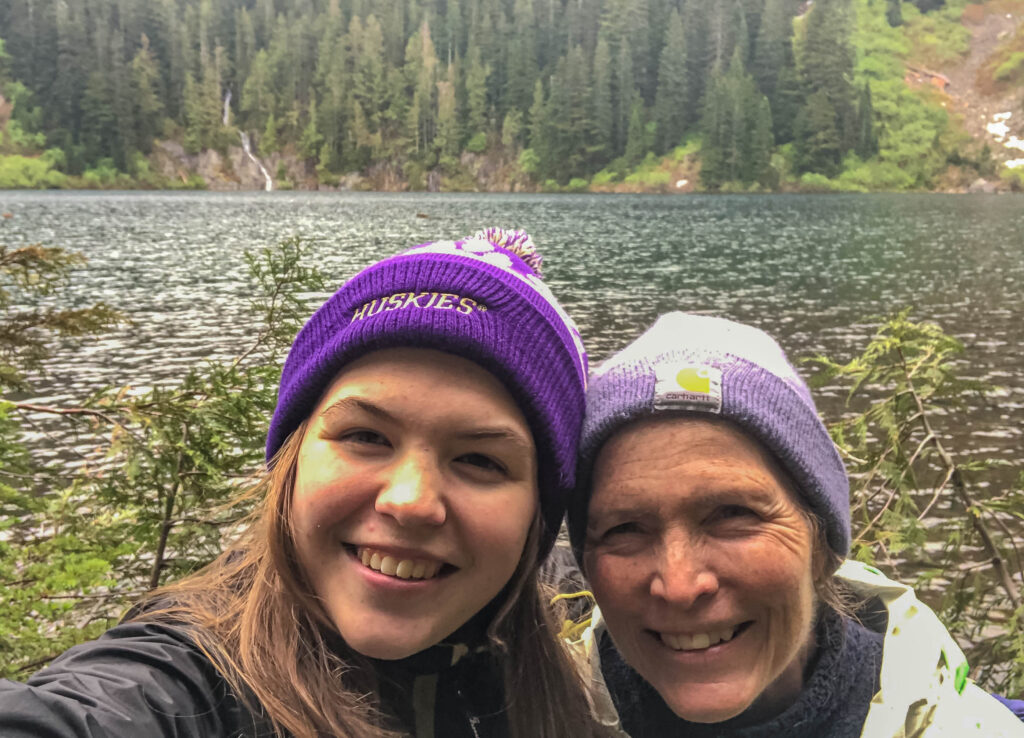


As a couple of my friends have expressed interest in hiking or even backpacking with me, the tips you provide in this latest post will come in handy – thank you! Unless prospective hikers already have a baseline (the way you did on the Teneriffe Falls hike), establishing one can make the following hikes much more enjoyable. Distance and cumulated elevation gain are indeed some key “metrics” to keep in mind as they speak to current “limitations” of our companion. On baseline hikes I have also made note of limitations very specific to my “buddy” for the day. One gentleman, my age, had lost half of his lung capacity to a former battle with cancer; in order to make sure he would never “push his limits” too far, I chose a destination where a network of interconnected trails allowed for a constant “reshaping” of our hike; by doing this, we established the proper pace for him as well as the length and steepness of uphill he could tolerate – this allowed me to propose later hikes where he could enjoy the experience without ever being in distress and, at least as important, without ever feeling he was a “drag” on our progress. Another hiking partner, while being younger than I, is very uncomfortable on steep and/or difficult downhill sections; after realizing how uncomfortable she was, I made sure to propose only trails I knew would not have any significant sections of “tough downhill”. You do also mention an aspect that I cannot agree more with: checking with each-other as we go. As the “expert” taking along an aspiring hiker, it is incumbent on me to closely observe my companion for any sign or discomfort, of boredom, or tiredness, etc. and to communicate on a regular basis to gauge whether (s)he is enjoying the experience or needs some adjustments to be made to our journey.
These are fabulous, Gerard, and excellent tips for anyone wanting to coach others to the joys of hiking. Observing how someone handles steep terrain or exposure is one I’d thought of but I had NOT thought of “break-off” trails in the case of needing to change distance. Local parks meet that criteria. Thanks for the great tips!
Lucky you to have Brooke on your Summer’s Hikes. You will have memorable moments together to share. 👍
Definitely. We will cherish the time, moments, and memories. Thanks for reading and commenting.